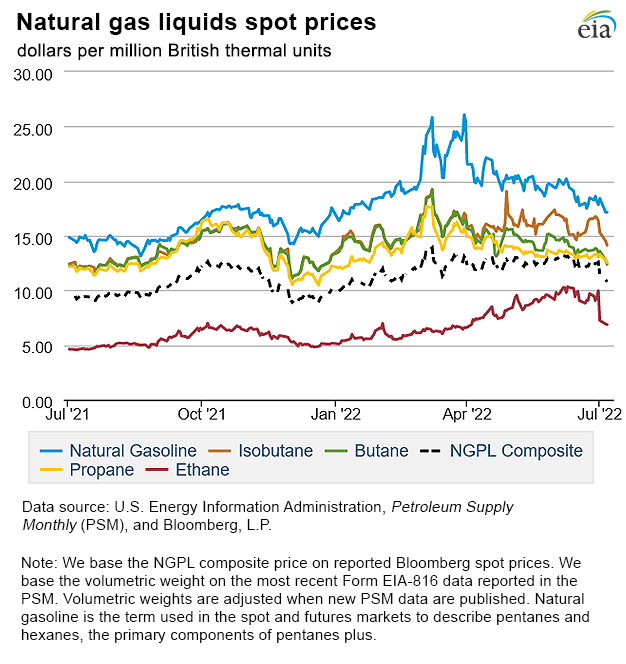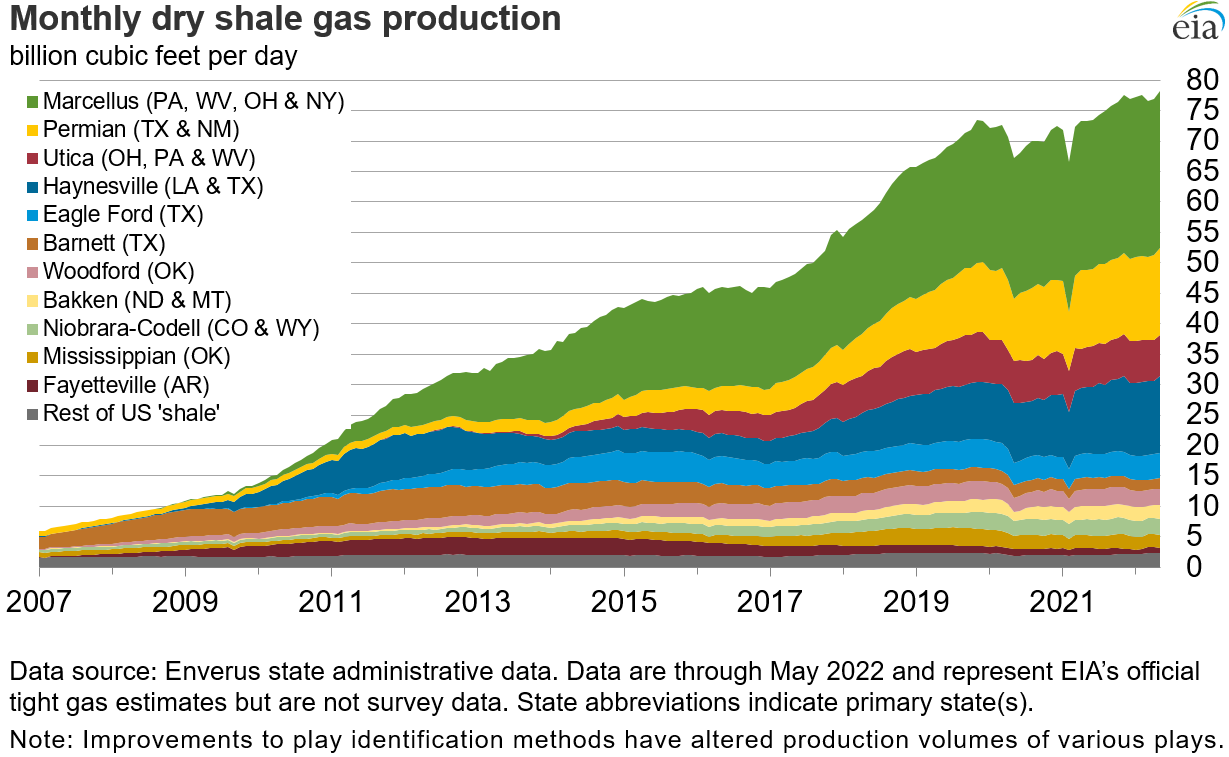In the News:
U.S. average monthly Henry Hub spot price more than doubles in 12 months
Over the past 12 months (July 2021–June 2022), the average monthly spot natural gas price at the U.S. Henry Hub benchmark has more than doubled, rising by $3.86 per million British thermal units (MMBtu) from $3.84/MMBtu in July 2021 to $7.70/MMBtu in June 2022, according to data from Refinitiv Eikon. Prices have generally increased over this period because inventory levels have remained below average as a result of demand growth outpacing growth in domestic production. The average inflation-adjusted (real) monthly Henry Hub spot price reached a 12-month high of $8.17/MMBtu in May 2022, the highest price since November 2008. From June 8 to July 6 natural gas prices decreased by about 40% as domestic natural gas supply and demand became more balanced, driven largely by an outage at the Freeport liquefied natural gas (LNG) export terminal.
In the summer of 2021, high demand for natural gas for electric power generation along with high levels of exports of natural gas led to lower-than-average inventory builds, putting upward pressure on prices. This upward price pressure continued until December 2021 when, as a result of mild weather and low space heating demand, natural gas inventories built back to their five-year (2016–2020) average level, putting downward pressure on prices. After reaching an average of $5.51/MMBtu in October 2021, the Henry Hub spot price decreased to $3.76/MMBtu in December 2021.
However, from January through March 2022, total consumption of natural gas exceeded the five-year (2017–2021) average as colder-than-normal temperatures returned. In addition, limitations on natural gas-to-coal switching in the electric power sector and growth in LNG exports as a result of increased LNG export capacity also contributed to higher overall U.S. natural gas demand. As a result, the United States entered the injection season in April with the least amount of natural gas in storage in three years, and the Henry Hub spot price increased each month from January 2022 through May 2022.
Incremental gains in U.S. natural gas demand—including domestic consumption and net exports—have outpaced increases in U.S. dry natural gas production. In our June Short-Term Energy Outlook (STEO), we estimate U.S. dry natural gas production averaged 95.0 billion cubic feet per day (Bcf/d) in the first half of 2022, down slightly from the second half of 2021 (a 0.2% decrease).
After reaching a nominal price of $8.14/MMBtu in May, the Henry Hub spot price decreased to a monthly average of $7.70/MMBtu in June following the shutdown of the Freeport LNG export terminal, which is not expected to partially resume operations until October 2022. The shutdown is estimated to have reduced U.S. export capacity by approximately 2.0 Bcf/d.
Overview:
(For the week ending Wednesday, July 6, 2022)
- Spot prices: Natural gas spot prices fell at most locations this report week (Wednesday, June 29 to Wednesday, July 6). The Henry Hub spot price fell from $6.67 per million British thermal units (MMBtu) last Wednesday to $5.63/MMBtu yesterday.
- International spot prices: International natural gas spot prices increased this report week. Bloomberg Finance, L.P., reports that the weekly average swap prices for liquefied natural gas (LNG) cargoes in East Asia increased $1.56 to a weekly average of $38.43/MMBtu. At the Title Transfer Facility (TTF) in the Netherlands, the most liquid natural gas spot market in Europe, the day-ahead price rose $7.62 to a weekly average of $47.99/MMBtu. The weekly average premium of TTF prices to East Asia was $9.56/MMBtu, the highest such premium since the second week of March, following Russia’s full-scale invasion of Ukraine. In the same week last year (week ending July 7, 2021), the prices in East Asia and at TTF were $13.17/MMBtu and $12.27/MMBtu, respectively.
- Futures: The price of the August 2022 NYMEX contract decreased 98.8 cents, from $6.498/MMBtu last Wednesday to $5.510/MMBtu yesterday. The price of the 12-month strip averaging August 2022 through July 2023 futures contracts declined 80.8 cents to $5.122/MMBtu.
- Storage: The net injections to working gas totaled 60 billion cubic feet (Bcf) for the week ending July 1. Working natural gas stocks totaled 2,311 Bcf, which is 10% lower than the year-ago level and 12% lower than the five-year (2017–2021) average for this week.
- NGPLs: The natural gas plant liquids composite price at Mont Belvieu, Texas, fell by 98 cents/MMBtu, averaging $11.46/MMBtu for the week ending July 6. The weekly average price of ethane fell 17%, outpacing the decline in natural gas prices at the Houston Ship Channel, which fell 9% week over week. As a result, the ethane premium to natural gas declined by 33% to $2.07/MMBtu, after reaching $3.10/MMBtu last week – the highest ethane-to-natural gas premium since the fourth quarter of 2018. Ethylene prices on the Gulf Coast also fell, but not as rapidly as ethane feedstock prices, resulting in a higher ethylene-to-ethane premium, which rose 4% week over week. Weekly average natural gasoline prices fell 3%, mirroring the decline in the Brent crude oil price, which also fell 3% week over week. Prices of other NGPLs also fell. Normal butane prices fell 5%. Isobutane prices fell 9%. The propane price fell 2%, reducing the propane-to-crude oil discount by 4%.
- Rigs: According to Baker Hughes, for the week ending Tuesday, June 28, the natural gas rig count decreased by 4 rigs from a week ago to 153 rigs. The Eagle Ford dropped two rigs, and the Marcellus and Utica each dropped one rig. The number of oil-directed rigs increased by 1 rig to 595 rigs. The Ardmore Woodford and the Arkoma Woodford each added one rig, and six rigs were added in unspecified producing regions. The Cana Woodford dropped five rigs, and the Eagle Ford dropped two rigs. The total rig count now stands at 750 rigs.
Prices/Supply/Demand:
Prices along the Gulf Coast fall, as temperatures moderate. This report week (Wednesday, June 29 to Wednesday, July 6), the Henry Hub spot price fell $1.04 from $6.67/MMBtu last Wednesday to $5.63/MMBtu yesterday. Total consumption of natural gas in all sectors along the Gulf Coast (South Texas and South Louisiana subregions) fell slightly by a combined 0.1 billion cubic feet per day (Bcf/d) (1%) this report week, according to data from PointLogic. Temperatures in the Houston Area averaged 85°F this week, 1°F higher than normal but 3°F lower than last report week. Natural gas deliveries to LNG export terminals in South Texas remained effectively unchanged at 2.3 Bcf/d, while deliveries to LNG export terminals in South Louisiana increased by 0.7 Bcf/d to 7.8 Bcf/d.
Prices in the Midwest fall with the national average. At the Chicago Citygate, the price decreased $1.19 from $6.55/MMBtu last Wednesday to $5.36/MMBtu yesterday. Natural gas consumption in the residential and commercial sectors in the Midwest increased by 0.4 Bcf/d (24%) and natural gas consumption in the electric power sector increased by 0.5 Bcf/d (16%) this report week, according to data from PointLogic. Temperatures in the Chicago Area averaged 78°F this report week, 3°F higher than normal.
Prices across the West fall as temperatures along the West Coast and across the Rocky Mountains moderate. The price at PG&E Citygate in Northern California fell $1.47, down from $7.80/MMBtu last Wednesday to $6.33/MMBtu yesterday. The price at Sumas on the Canada-Washington border fell $1.08 from $5.01/MMBtu last Wednesday to $3.93/MMBtu yesterday. In the Seattle City Area, temperatures averaged 63°F, which is 1°F lower than normal and 4°F lower than last report week.
The price at SoCal Citygate in Southern California decreased $1.53 from $6.98/MMBtu last Wednesday to $5.45/MMBtu yesterday, as above-normal temperatures gave way to slightly below-normal temperatures. In the Riverside Area, inland from Los Angeles, temperatures averaged 76°F this report week, which is 1°F lower than normal and 8°F lower than last report week. Natural gas consumption in the electric power sector decreased week over week by 0.9 Bcf/d (38%) in California, according to data from PointLogic.
Prices in the Northeast decline in advance of lower temperatures and ample pipeline capacity. At the Algonquin Citygate, which serves Boston-area consumers, the price decreased $2.24 from $7.51/MMBtu last Wednesday to $5.27/MMBtu yesterday. At the Transcontinental Pipeline Zone 6 trading point for New York City, the price decreased $1.34 from $6.51/MMBtu last Wednesday to $5.17/MMBtu yesterday. Temperatures in New England are forecast to fall ahead of the weekend and reach an average 66°F, 5°F below normal, on July 10. Algonquin Gas Transmission issued an operational flow order (Notice Identifier 122582) from July 9 through July 11 requiring all customers to receive their full scheduled deliveries, with penalties assessed on customers who remove from the pipeline less natural gas than scheduled, in order to maintain operating integrity of their system.
Prices in the Appalachian Basin decline along with other major pricing hubs. The Tennessee Zone 4 Marcellus spot price decreased 82 cents from $5.67/MMBtu last Wednesday to $4.85/MMBtu yesterday. The price at Eastern Gas South in southwest Pennsylvania fell $1.17 from $6.17/MMBtu last Wednesday to $5.00/MMBtu yesterday.
Prices in the Permian Basin fall even as supply decreases slightly and demand remains unchanged week over week. The price at the Waha Hub in West Texas, which is located near Permian Basin production activities, fell 89 cents this report week, from $6.21/MMBtu last Wednesday to $5.32/MMBtu yesterday. The Waha Hub traded 31 cents below the Henry Hub price yesterday, compared with last Wednesday when it traded 46 cents below the Henry Hub price. Production on the New Mexico side of the Permian Basin declined by 0.1 Bcf/d (3%), according to data from PointLogic. Slight increases in other areas of the producing region somewhat offset this decrease, resulting in a 1% overall decrease in total supply. Total demand in the Permian production region was unchanged week over week, largely as a result of net natural gas flows out of the production region remaining steady at 13.1 Bcf/d.
U.S. natural gas supply increases slightly week over week. Overall U.S. natural gas supply rose by 0.1% (0.2 Bcf/d) week over week to 101.7 Bcf/d, according to data from PointLogic. Dry natural gas production grew by 0.1% (0.1 Bcf/d) to 96.0 Bcf/d, and net imports from Canada increased by 1.3% (0.1 Bcf/d) from last week.
U.S. natural gas demand rises as a result of temperature swings across the country. Total U.S. consumption of natural gas rose by 1.8% (1.3 Bcf/d) compared with the previous report week, according to data from PointLogic. Weekly average temperatures were mixed, with slightly above-normal temperatures in the Desert Southwest, Texas, and much of the Midcontinent, and slightly below-normal temperatures in California, the Great Lakes region, and the Northeast this report week. Natural gas consumed for power generation climbed by 2.6% (1.0 Bcf/d) week over week, and in the residential and commercial sectors, consumption increased by 4.1% (0.3 Bcf/d). Industrial sector consumption fell by 0.5% (0.1 Bcf/d) week over week, while natural gas exports to Mexico were essentially unchanged. Natural gas deliveries to U.S. liquefied natural gas (LNG) export facilities (LNG pipeline receipts) averaged 11.2 Bcf/d, or 0.7 Bcf/d higher than last week.
U.S. LNG exports increase by one vessel this week from last week. Nineteen LNG vessels (nine from Sabine Pass, four from Corpus Christi, three from Cameron, two from Cove Point, and one from Calcasieu Pass) with a combined LNG-carrying capacity of 71 Bcf departed the United States between June 30 and July 6 according to shipping data provided by Bloomberg Finance, L.P.
Correction: Last week, one more vessel than was originally reported departed the United States. We corrected last week's count to reflect a total of 18 vessels departing the United States between June 23 and June 29 with a combined LNG-carrying capacity of 66 Bcf. The additional vessel departed from Elba Island.
Storage:
The net injections into storage totaled 60 Bcf for the week ending July 1, compared with the five-year (2017–2021) average net injections of 60 Bcf and last year's net injections of 25 Bcf during the same week. Working natural gas stocks totaled 2,311 Bcf, which is 322 Bcf lower than the five-year average and 261 Bcf lower than last year at this time.
According to The Desk survey of natural gas analysts, estimates of the weekly net change to working natural gas stocks ranged from net injections of 59 Bcf to 81 Bcf, with a median estimate of 72 Bcf.
The average rate of injections into storage is 4% lower than the five-year average so far in the refill season (April through October). If the rate of injections into storage matched the five-year average of 8.3 Bcf/d for the remainder of the refill season, the total inventory would be 3,323 Bcf on October 31, which is 322 Bcf lower than the five-year average of 3,645 Bcf for that time of year.
More storage data and analysis can be found on the Natural Gas Storage Dashboard and the Weekly Natural Gas Storage Report.
See also:
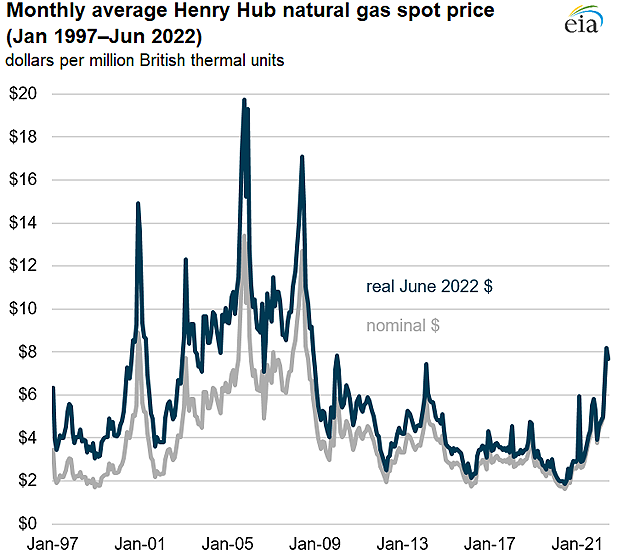 Data source: U.S. Energy Information Administration, Natural Gas Spot and Futures Prices, based on Refinitiv Eikon data
Data source: U.S. Energy Information Administration, Natural Gas Spot and Futures Prices, based on Refinitiv Eikon data
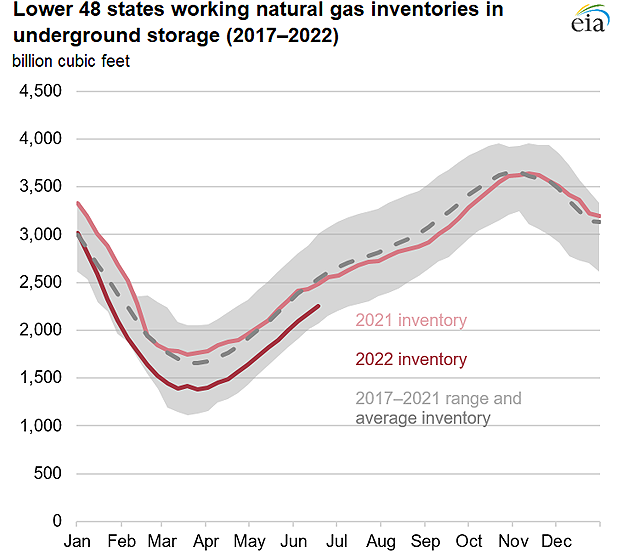 Data source: U.S. Energy Information Administration, Weekly Natural Gas Storage Report
Data source: U.S. Energy Information Administration, Weekly Natural Gas Storage Report
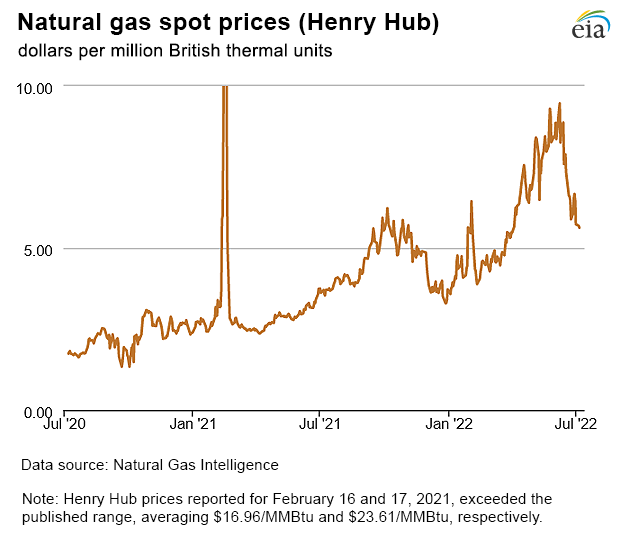
| Spot Prices ($/MMBtu) | Thu, 30-Jun |
Fri, 1-Jul |
Mon, 4-Jul |
Tue, 5-Jul |
Wed, 6-Jul |
|---|---|---|---|---|---|
| Henry Hub | 6.46 | 5.73 | Holiday | 5.69 | 5.63 |
| New York | 5.95 | 5.16 | Holiday | 5.33 | 5.17 |
| Chicago | 6.10 | 5.39 | Holiday | 5.40 | 5.36 |
| Cal. Comp. Avg.* | 6.57 | 5.56 | Holiday | 5.67 | 5.64 |
| Futures ($/MMBtu) | |||||
| August Contract | 5.424 | 5.730 | Holiday | 5.523 | 5.510 |
| September Contract | 5.392 | 5.712 | Holiday | 5.487 | 5.482 |
| Data source: Natural Gas Intelligence and CME Group as compiled by Bloomberg, L.P. *Avg. of NGI's reported prices for: Malin, PG&E Citygate, and Southern California Border Avg. |
|||||
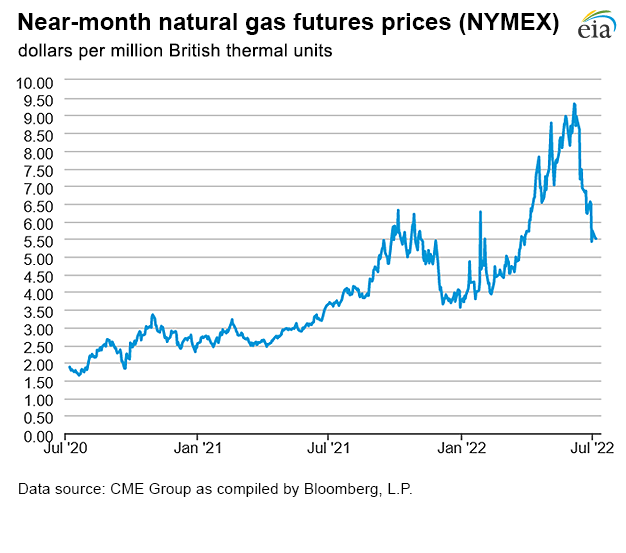
| U.S. natural gas supply - Gas Week: (6/30/22 - 7/6/22) | |||
|---|---|---|---|
Average daily values (billion cubic feet) |
|||
this week |
last week |
last year |
|
| Marketed production | 108.1 |
108.0 |
103.9 |
| Dry production | 96.0 |
95.9 |
91.7 |
| Net Canada imports | 5.7 |
5.6 |
5.0 |
| LNG pipeline deliveries | 0.1 |
0.1 |
0.1 |
| Total supply | 101.7 |
101.6 |
96.7 |
|
Data source: PointLogic | |||
| U.S. natural gas consumption - Gas Week: (6/30/22 - 7/6/22) | |||
|---|---|---|---|
Average daily values (billion cubic feet) |
|||
this week |
last week |
last year |
|
| U.S. consumption | 69.8 |
68.5 |
67.2 |
| Power | 40.2 |
39.2 |
37.7 |
| Industrial | 20.9 |
21.0 |
21.1 |
| Residential/commercial | 8.7 |
8.4 |
8.5 |
| Mexico exports | 5.9 |
5.8 |
6.4 |
| Pipeline fuel use/losses | 6.6 |
6.5 |
6.3 |
| LNG pipeline receipts | 11.2 |
10.5 |
11.0 |
| Total demand | 93.4 |
91.4 |
90.9 |
|
Data source: PointLogic | |||
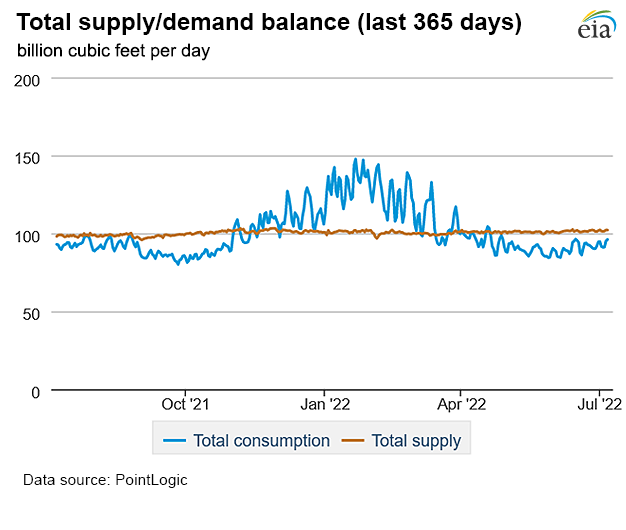
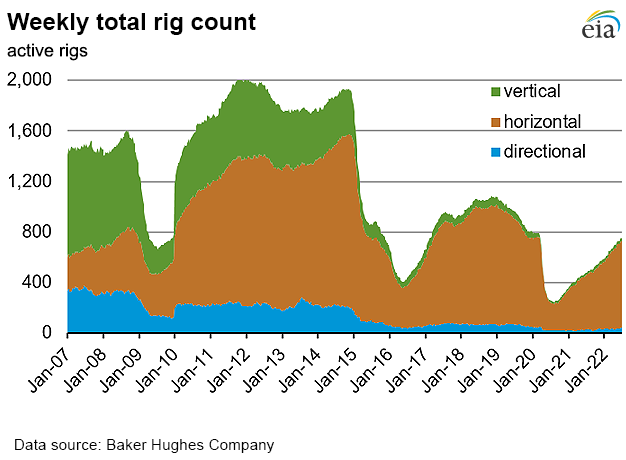
| Rigs | |||
|---|---|---|---|
Tue, June 28, 2022 |
Change from |
||
last week |
last year |
||
| Oil rigs | 595 |
0.2% |
58.2% |
| Natural gas rigs | 153 |
-2.5% |
54.5% |
| Note: Excludes any miscellaneous rigs | |||
| Rig numbers by type | |||
|---|---|---|---|
Tue, June 28, 2022 |
Change from |
||
last week |
last year |
||
| Vertical | 25 |
-7.4% |
56.3% |
| Horizontal | 682 |
-0.4% |
59.0% |
| Directional | 43 |
4.9% |
43.3% |
| Data source: Baker Hughes Company | |||
| Working gas in underground storage | ||||
|---|---|---|---|---|
Stocks billion cubic feet (Bcf) |
||||
| Region | 2022-07-01 |
2022-06-24 |
change |
|
| East | 482 |
461 |
21 |
|
| Midwest | 562 |
535 |
27 |
|
| Mountain | 138 |
134 |
4 |
|
| Pacific | 240 |
235 |
5 |
|
| South Central | 890 |
886 |
4 |
|
| Total | 2,311 |
2,251 |
60 |
|
| Data source: U.S. Energy Information Administration Form EIA-912, Weekly Underground Natural Gas Storage Report | ||||
| Working gas in underground storage | |||||
|---|---|---|---|---|---|
Historical comparisons |
|||||
Year ago (7/1/21) |
5-year average (2017-2021) |
||||
| Region | Stocks (Bcf) |
% change |
Stocks (Bcf) |
% change |
|
| East | 520 |
-7.3 |
548 |
-12.0 |
|
| Midwest | 636 |
-11.6 |
627 |
-10.4 |
|
| Mountain | 176 |
-21.6 |
164 |
-15.9 |
|
| Pacific | 246 |
-2.4 |
272 |
-11.8 |
|
| South Central | 993 |
-10.4 |
1,023 |
-13.0 |
|
| Total | 2,572 |
-10.1 |
2,633 |
-12.2 |
|
| Data source: U.S. Energy Information Administration Form EIA-912, Weekly Underground Natural Gas Storage Report | |||||
| Temperature – heating & cooling degree days (week ending Jun 30) | ||||||||
|---|---|---|---|---|---|---|---|---|
HDDs |
CDDs |
|||||||
| Region | Current total |
Deviation from normal |
Deviation from last year |
Current total |
Deviation from normal |
Deviation from last year |
||
| New England | 2 |
-2 |
-3 |
33 |
8 |
-33 |
||
| Middle Atlantic | 2 |
0 |
-1 |
44 |
4 |
-31 |
||
| E N Central | 5 |
2 |
4 |
42 |
-3 |
-27 |
||
| W N Central | 4 |
-1 |
3 |
55 |
-3 |
-4 |
||
| South Atlantic | 0 |
0 |
-1 |
88 |
1 |
0 |
||
| E S Central | 0 |
0 |
0 |
88 |
5 |
-2 |
||
| W S Central | 0 |
0 |
0 |
123 |
9 |
10 |
||
| Mountain | 6 |
-7 |
-2 |
69 |
2 |
0 |
||
| Pacific | 2 |
-7 |
2 |
61 |
29 |
-1 |
||
| United States | 2 |
-1 |
1 |
68 |
6 |
-10 |
||
|
Data source: National Oceanic and Atmospheric Administration Note: HDDs=heating degree days; CDDs=cooling degree days | ||||||||
Average temperature (°F)
7-day mean ending Jun 30, 2022
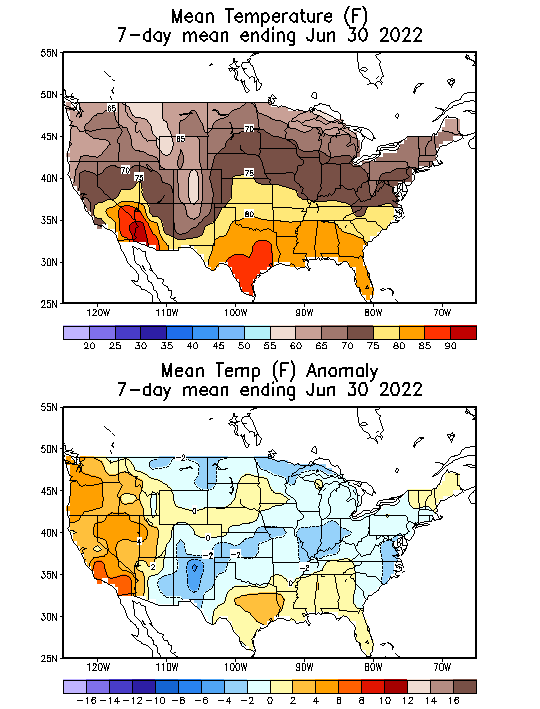
Data source: National Oceanic and Atmospheric Administration
Deviation between average and normal temperature (°F)
7-day mean ending Jun 30, 2022

Data source: National Oceanic and Atmospheric Administration

